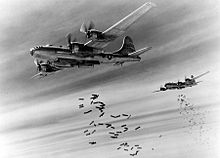
Back الحرب الجوية في الحرب العالمية الثانية Arabic İkinci Dünya müharibəsində aviasiyadan istifadə Azerbaijani Luftkrieg im Zweiten Weltkrieg German Αεροπορικός οπλισμός του Β΄ Παγκοσμίου Πολέμου Greek جنگ هوایی جنگ جهانی دوم Persian Aviation dans la Seconde Guerre mondiale French לוחמה אווירית במלחמת העולם השנייה HE Légi hadviselés a második világháborúban Hungarian Aviazione nella seconda guerra mondiale Italian Применение авиации во Второй мировой войне Russian

Air warfare was a major component in all theaters of World War II and, together with anti-aircraft warfare, consumed a large fraction of the industrial output of the major powers. Germany and Japan depended on air forces that were closely integrated with land and naval forces; the Axis powers downplayed the advantage of fleets of strategic bombers and were late in appreciating the need to defend against Allied strategic bombing. By contrast, Britain and the United States took an approach that greatly emphasized strategic bombing and (to a lesser degree) tactical control of the battlefield by air as well as adequate air defenses. Both Britain and the U.S. built substantially larger strategic forces of large, long-range bombers. Simultaneously, they built tactical air forces that could win air superiority over the battlefields, thereby giving vital assistance to ground troops. The U.S. Navy and Royal Navy also built a powerful naval-air component based on aircraft carriers, as did the Imperial Japanese Navy; these played the central role in the war at sea.[1]
- ^ R.J. Overy, The Air War: 1939–1945 (1980) ch 1